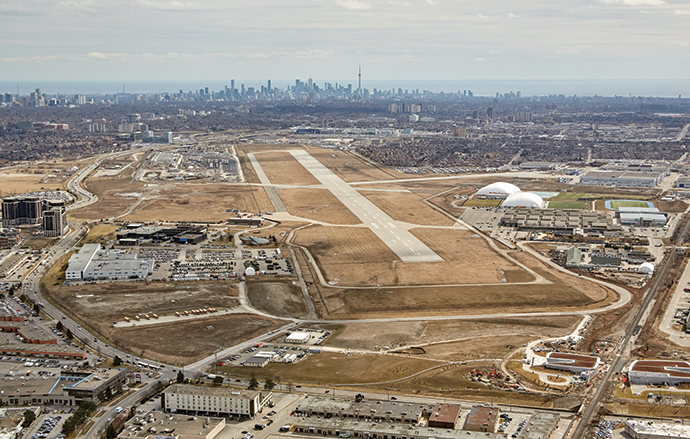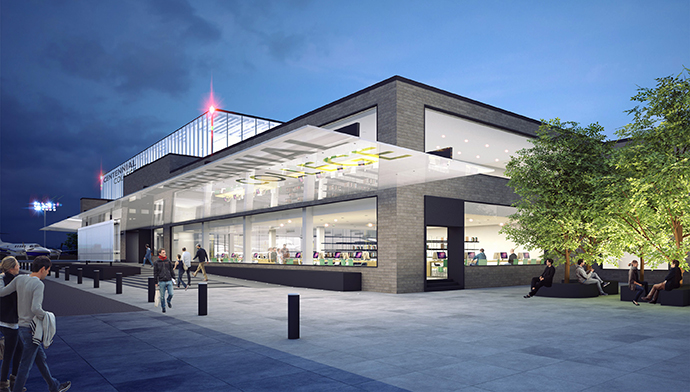North of downtown Toronto, the area called Downsview is surrounded by places with names evoking the English countryside: Bathurst, Jane and Finch, Thistletown, Yorkdale. Two golf courses are in close proximity to the area.
The place’s history is anything but leafy and bucolic, however, as the property carries a 90-year-old aerospace industry legacy.
It was here in 1929 that de Havilland Aircraft of Canada launched with 35 people in a small plant next to the railway, eventually making the Chipmunk aircraft and the World War II-era Tiger Moth fighter. According to a history of the site kept by the new Downsview Aerospace Innovation & Research (DAIR) hub maintained by Centennial College, the factory was Canada’s largest supplier of military, civilian and government owned aircraft in the 1930s, renamed RCAF Station Downsview during World War II, and saw production by de Havilland Canada (DHC) after the war of designs uniquely suited to the harsh Canadian operating environment.
“In the 1980s, the Canadian government privatized DHC and in 1986 sold the aircraft company to then Seattle-based Boeing,” says the account. But DHC was eventually acquired in 1992 by Montreal-based Bombardier Aerospace, which today employs roughly 3,500 at the site.
Fast forward to a January 12, 2018, when Montréal-based Bombardier released the following statement:
“Bombardier is in the midst of a five-year turnaround plan to ensure our long-term success as a company. As part of this turnaround plan, we have been reviewing our facilities worldwide — including Downsview — to ensure we have the most efficient and cost-effective operations necessary to support our growth objectives. We remain committed to strongly supporting the Ontario aerospace industry and the Downsview Aerospace Innovation and Research Initiative, as we look at options for our Downsview site. Behind this review is the fact that Bombardier currently uses only about 10 percent of a 375-acre [152-hectare] site and bears the entire cost of operating a 7,000-foot runway.
“We understand that the property’s unique location, proximity to public transit, major highways, universities and shopping make it an ideal location for employment and other uses,” the company said, almost making a sales pitch in the middle of breaking the bad news, “and we will work with all stakeholders throughout our review process.”
Indeed, if any parcel in the Greater Toronto Area (GTA) were to be called prime-cut real estate, this would be it.
“Take the GTA and put your finger in the middle of that map,” says Andrew Petrou, executive director of the DAIR project for the college. “Downsview is dead center. Overlap that with the fact that over 80 percent of aerospace activity in Ontario is within the GTA. A brand new GO train terminal opened this past December, with links in every direction. And you’re 15 minutes from Toronto Pearson International Airport” — a location touted as a likely landing spot if Bombardier moves.
Leveraging Value
One of the stakeholders in the Bombardier outcome is Ontario Premier Kathleen Wynne. “The Premier is aware of the situation and has asked her team to do everything they can to retain these jobs and the important aerospace sector in Ontario,” says her senior press secretary Jennifer Beaudry.
In a subsequent statement sent to Site Selection, Ontario Minister of Economic Development and Growth Steven Del Duca said, “Bombardier has indicated publicly that they are committed to having a continued presence in Ontario. A highly skilled workforce continues to be a key priority for the province, and we recognize the importance of the Bombardier jobs. We are in close contact with Bombardier and are watching this matter carefully.” Noting that a commitment to the DAIR hub remains a key priority for the province, the city and the federal government, Minister Del Duca said, “The Government of Ontario is deeply engaged with all stakeholders to ensure the long-term growth and sustainability of Ontario’s aerospace sector, and the security of the jobs of the Ontario workers who work in it.”
The news was just the latest disappointment from Bombardier to Toronto Mayor John Tory’s office. A year ago, as the company’s railcar division delivered its 30th streetcar to the city on a date by which the streetcar tally should have been 100, Tory called the company’s performance “totally inadequate” and questioned whether the firm would even be asked to bid on future contracts. In an emailed statement, Mayor Tory says, "I am aware of Bombardier’s plans to shift production away from Downsview. My office has been in discussions with the provincial and federal governments as to how to protect — and even grow — jobs at Downsview and protect public investments made there over the years.”
Reached by phone in February, Simon Letendre, senior advisor, media relations and public affairs for Bombardier’s corporate office, said it was still early days as the company evaluated different options and talked with different stakeholders.
“Sale is one of the options, but it’s not definitive that this will be the end result,” he said. “Right now we’re looking at this site and the value it represents, and how we could leverage it.”
It’s one of about 73 Bombardier production and engineering sites around the world, he said, though he wouldn’t say how many of those are under review. “We’re just trying to make sure each of our sites is cost-efficient and effective, and that we use it in the best possible way.”
Blindsided
It’s been a rollercoaster ride for the Canadian aerospace sector. After the punch in the gut of the Downsview news, the United States International Trade Commission ruled in favor of Bombardier in a tariff case brought by Boeing that previously had upheld a nearly 300-percent tariff on Bombardier’s C-Series aircraft. Victory was in the air. Then things took a sickening lurch a month later, when Canadian Minister of Innovation, Science and Economic Development Navdeep Bains on February 15 announced Canada’s five superclusters that would receive a collective C$950 million in federal funding to be matched by the private sector. One of the nine finalist proposals — Mobility Systems and Technologies for the 21st Century (MOST21), led by Montreal-based CAE and other partners — was centered around aerospace. But it was not chosen.
Innovation, Science and Economic Development Canada says Ontario’s aerospace sector represents 23 percent (C$5.3 billion) of Canada’s revenues, and employs over 17,000 skilled workers. Canada ranked third in terms of global civil aircraft production activity as recently as 2015, when it was also the nation’s No. 1 R&D investor across all manufacturing sectors.
The five superclusters chosen were more oriented toward geographic representation than reflection of the Canadian economy, in which Ontario plays an outsized role with nearly 40 percent of Canada’s GDP (2016). Only one of the five will be based in Ontario, but its scope — advanced manufacturing — at least could be said to encompass aerospace.

Many of the Downsview workers are members of UNIFOR Locals 112 and 673, representing around 3,200 workers in the Toronto area. Union local leaders began talks with the company on January 22, after receiving positive support from city and provincial leaders and national union members. “After these meetings, we have concluded the best position for our members is to maintain this facility, all jobs and future work. We remain steadfast in this commitment,” union leaders wrote to members in a letter. “Bombardier always speaks of transparency, yet we were completely left out of the loop on this decision. Your committee members are as angry and frustrated as you are, but we are focused on achieving a positive outcome for all members.”
Scott McIlmoyle, president of UNIFOR Local 112, is a 33-year veteran of the site, where he met his wife Mary Ellen, who serves as president of UNIFOR Local 673, the office union. Altogether, the two locals represent about half of the workers at Downsview. In a phone interview in February, he said the supercluster news was disappointing, and he’s working to avoid further disappointment.
Asked how union leadership was informed of the company’s intentions, he says, “The company brought us into a meeting a week before Christmas, and said their intentions were to sell the site and move products over toward Pearson. It was their intentions, but nothing was firmed up. It’s like family saying, ‘We’re going to move, we’re not sure where, but we’ve put the house up for sale.’ People are asking, ‘Where are we going? What’s going on?’
“Morale is, safe to say, at an all-time low,” he continued, even as orders are booming for the company’s Global 7000 business aircraft, and global aircraft orders in general are piling up. “For a lot of people, it’s where we grew up,” he says of Downsview. “To realize the possibility that the company’s intentions are to look at moving that is bothersome. It really tears at the heart of a piece of the fabric of the community for many years.”
The disappointment is especially sharp, says McIlmoyle, given the union’s rally on behalf of Bombardier last fall during the tariff battle over the C-Series aircraft, which aren’t even made at the Downsview site.
“Our members say, ‘Wait a second, we went out to support you and push back on the tariffs, and now you turn around and want to move the plant.’ The biggest thing is the uncertainty of the future.”
If indeed the company moves forward with moving, there may be some constraints on what the site could become, given adjacent property’s official government status as employment lands.
The union’s current agreement with Bombardier expires on June 23, 2018. “We are sitting with the company and formulating proposals regarding our normal demands at the bargaining table,” McIlmoyle says. “We will have bigger discussions as their plans become more firmed up. Our number one issue is job security moving forward.”
Growing, Not Shrinking
As for the DAIR hub’s vision of that future, McIlmoyle says the union is completely in support of what he calls a “huge” initiative. “We have to be training to have qualified youth and our next generation of aircraft assemblers.”
The federal and provincial governments in late 2016 committed nearly $44 million to relocate and expand Centennial College’s aerospace program as a first step toward creating the hub. At the time, KPMG estimated the initiative would create some 14,400 jobs and contribute $2.3 billion in direct and indirect benefits to the economy over the next 20 years. Among other aspects, the $72-million project will aid Centennial in tripling its aircraft technician and avionics training enrollment to more than 1,000 students.
DAIR Executive Director Andrew Petrou says his communications with Bombardier have been focused specifically on DAIR, not on the company’s operations. “I’m praying there is a solution that appeases everyone,” he says.
Petrou was the chief author of the Emerson Report, which made the case several years ago for growing the aerospace industry. The key question he asked company leaders, he says, was “How do we keep you here?” The answer? “They said, ‘If you have R&D activity, it drives companies to want to be in that R&D interaction.’ That outputs products, which output growth and jobs.”
If that output and knowledge is distilled and focused in a campus-like setting, it can be amplified, he says. For example, roughly 60 percent of landing gear is produced in southern Ontario by the likes of Safran, United Technologies. “We could be world-renowned for technologies for landing gear,” he says.
Asked about other DAIR stakeholder companies, Petrou says there is a big push to replenish the workforce: “No one has said, ‘We’re shrinking.’ Everyone is saying, ‘We’re growing.’”
He compares the site’s potential to the successful collaborative research and global opportunities emerging from the ICT incubator/accelerator Communitech in Waterloo. But it can’t be prescribed, he says. Specializations emerge on their own from the physical proximity of pioneering innovators, in the spirit of those who came before.
“Simple human interaction beyond a computer can go so far,” he says. “Just build the playground, and let those themes grow.”

